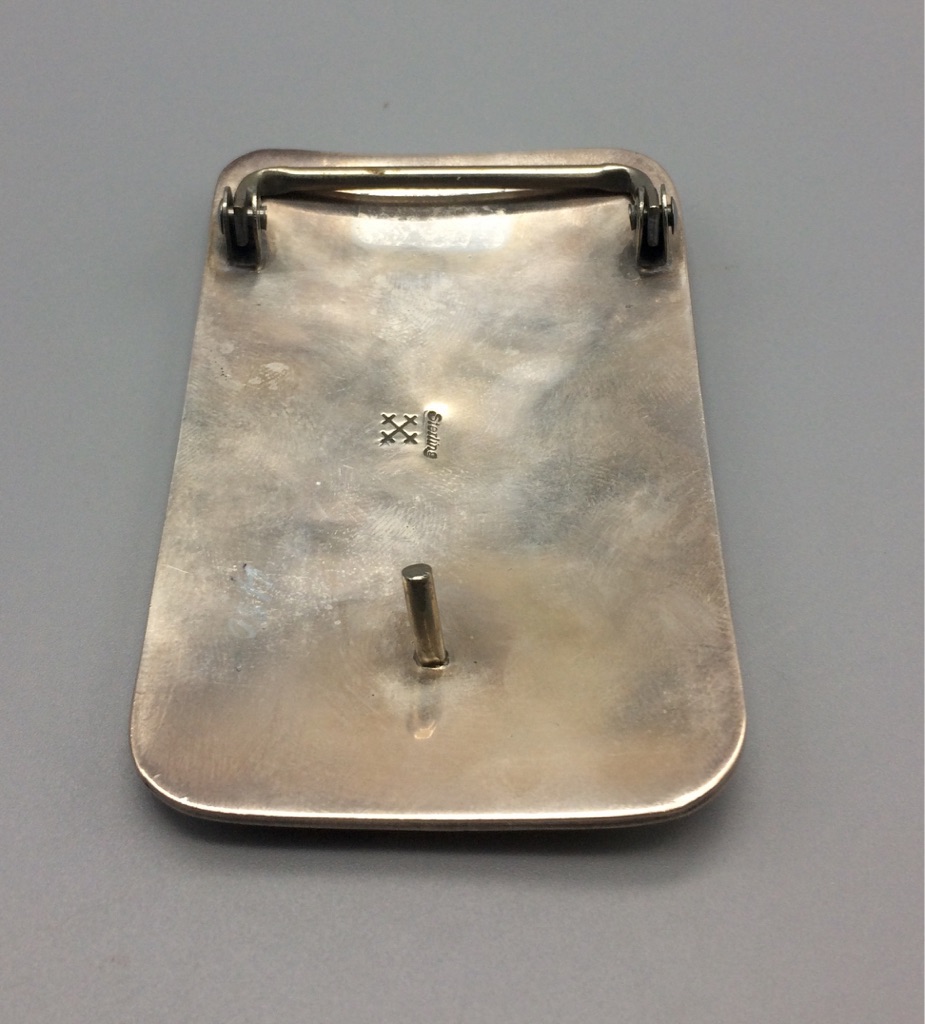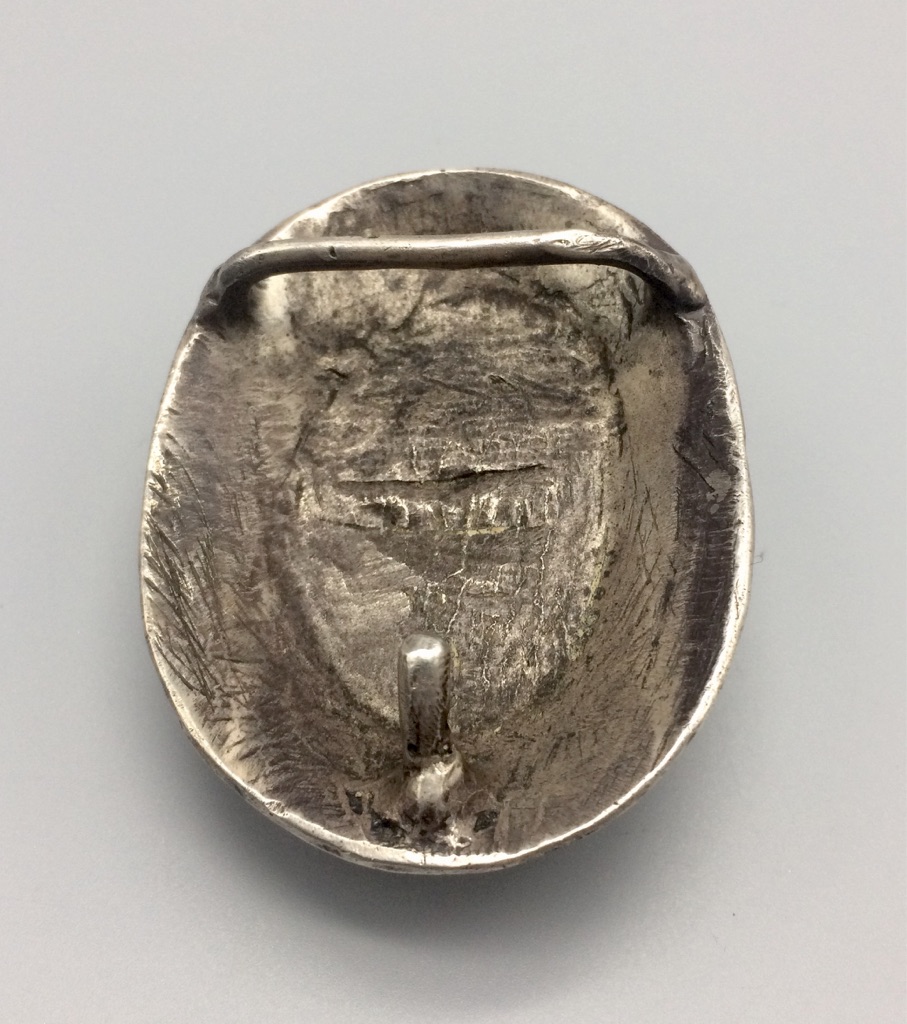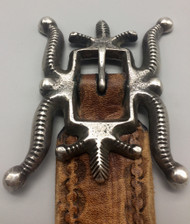Dating Belt Buckles
Posted by Jim Olson on Sep 29th 2017
To dealers and collectors of vintage and antique Native American Indian jewelry, dating a piece is often tricky. Of course, there are certain tell-tale signs, such as design, materials and construction, wear and patina, hallmarks, etc.. There are numerous examples of older pieces in books to compare with also. But all of the above has many variables and can be misleading. Older styles are often copied. Wear and patina can be simulated. With regards to belt buckles, one question I have often been asked (and seen pop up in various social media chats) is, “When did the swivel bar (hinge) on the back of belt buckles first start being used?” (As opposed to a solid bar on the back to attach the belt.)

It seems a valid question with regards to helping ascertain a date range for a belt buckle. Not many people (including the multitude of Facebook experts, LOL) had come up with very solid answers. A google search does not give you a good answer. There is no patent on it (or we could look up the patent date). An online search of say, 1950s turquoise belt buckles, will turn up a multitude of buckles which claim to be from the 50s time period — and many have a swivel back. Is this correct, or possible?
Being a life-long collector of Western memorabilia and an owner of a Trading Post, I have handled a fair amount of buckles. I felt I knew the answer to the above-stated question just off the top of my head, but then thought, “What hard facts do you have to back up your opinion?” Most Native jewelry dating is subjective. You can ask 10 different experts an opinion, and you will often get 10 different opinions! So I thought, the easiest belt buckle in the world to date is a Western-style, trophy or championship belt buckle because the date is right there on the front 9 out of 10 times. So I researched numerous trophy buckles in search of an answer to the question because it stands to reason that Native-made buckles would have followed closely on the trend.
First off, before WWII, there were very few championship belt buckles awarded (rodeo or otherwise). The couple of examples I have seen had a solid bar on the back. Western buckles, in general, were not seen much before the 1920s and did not get popular until the 1930s and ‘40s. Jeans did not even have belt loops until the early ‘20s. Prior to that, folks mostly wore suspenders. During the latter part of the 1940s, trophy buckles started catching on as a prize at equine events, and into the 1950s you begin to see more of them. By the 1960s they were fairly common. They were made largely by Comstock, Don Ricardo, Bohlin and a few others during the early years.
The earliest examples of a swivel bar on the back was a handmade job, not commercially made, and it varied in style from maker to maker. So just when did it become a common item that could be purchased at a jewelry supply store? That is the million dollar question!
Probably the earliest examples of a swivel back I have encountered were on buckles made in Mexico—and probably during the 1940s. But again, those were not commercial made swivel bars. During the 1950s, companies such as those mentioned above were using the swivel back on some buckles—also of their own manufacture and not commercially produced. More often than not, however, buckles from before 1960 had a solid bar on the back.

As we get into the 1960s, you still see a lot of solid bar buckles, but the “custom” or “shop made” swivel was becoming more common. No examples of a commercial swivel bar (like we see common today) were found on any (verifiable) early 1960s buckles that I have seen. By the late 1960s however, they start to pop up—but not very common yet. In the early 1970s, companies like Montana Silversmiths (and others) came onto the scene, and by then buckles were made en masse. Yet it was more into the mid-70s before the commercial made swivel back caught on with any number.
Now back to the Indian made buckles we treasure and collect. The first buckles made by Natives had a bar with a tongue across an open center that the belt looped around. The opening was usually fairly narrow, not more than an inch or so and usually smaller. This style was used from the earliest days of Native silver-work and is found on the ever popular concho belts, and smaller versions were also used on horse bridles. In response to the “Western-style” belt buckle becoming popular circa the 1930s, you start to see some Native made buckles around then which were not necessarily made for concho belts but made instead to fit the western-style leather belt. It was during this time or shortly after the bar began to move to the back of the buckle, on the left side, but early examples of these are still fairly rare. Mostly the Natives still made a “concho” style buckle. This transition to a solid bar on the left side took years to complete. However, once it becomes the style, it was used pretty much until the commercial swivel bar showed up in the early ‘70s.
Although some of the companies mentioned above were using a handmade and later a commercial made swivel bar, they were cranking out many buckles. Your average Native silversmith made perhaps a few buckles per year, so it did not make sense to buy the commercial made, hinged bars when a solid bar could be made fairly easily and cheaply. So the commercial swivel bar does not show up much in Native-made belt buckles until a little later than some other Western buckles. Also, prior to the early 1970s, most Native silver was more of a hand-made affair (outside of the companies that produced large quantities anyway). Then, in the early 70s, a turquoise jewelry boom happened. It was during this time you see more of the “assembled” type of work begin to happen among individual smiths. In response to a huge demand, it was easier and quicker for some to simply go to the jewelry supply store and buy a bunch of pre-made parts and assemble them. Of course, a select group still made things by hand.
In summary, if you have a Native made belt buckle with a swivel bar (hinge) on the back, it was probably made in the early 1970s or later. It is possible to have been made before that, but not very likely. If your belt buckle has a handmade swivel bar on the back, it probably came from the 1950s through early 70s time period, but not many examples of these are found in Native-made buckles. They seemed to prefer the solid bar right up till the time a commercial swivel type was available.
On the other hand, having a solid bar on the back does not necessarily mean it is an early buckle. There are many fine buckles being made to this day in the “old-school” style with a solid bar. In this case, you have to rely on the tell-tale signs mentioned in the beginning to help date it. There are some variables of course, like buckles that have been repaired or repurposed. I recently saw a picture of a belt buckle on a social media site claiming it was by a certain silversmith who would have had to make it sometime in the 1930s or earlier. There was a picture of the front and back posted. The front looked good, but the back had a commercial made swivel hinged bar. I immediately thought, “this buckle cannot be that old!” Of course, it is never wise to jump to conclusions quickly (although it is human nature). Upon reading the information in the post, it was disclosed the buckle was an old concho which had been converted to a belt buckle in more recent times. Obviously, the smith who did the work used a commercial hinged bar and closer.
Examination of the photo revealed signs of the conversion. So there is a prime example of not dating your belt buckle (or any other pieces) before looking over the item thoroughly (preferably by hand and not from a picture — pictures can be deceiving).
I hope this has helped to answer some of the questions concerning vintage and antique belt buckles.
View our online inventory of belt buckles here.
Jim Olson © 2017
www.WesternTradingPost.com

